I just received a record album in the mail. It’s an EP (German label) with this avian hipster on the cover … Clive the Racing Pigeon in his best Blue-Note-Records pose.
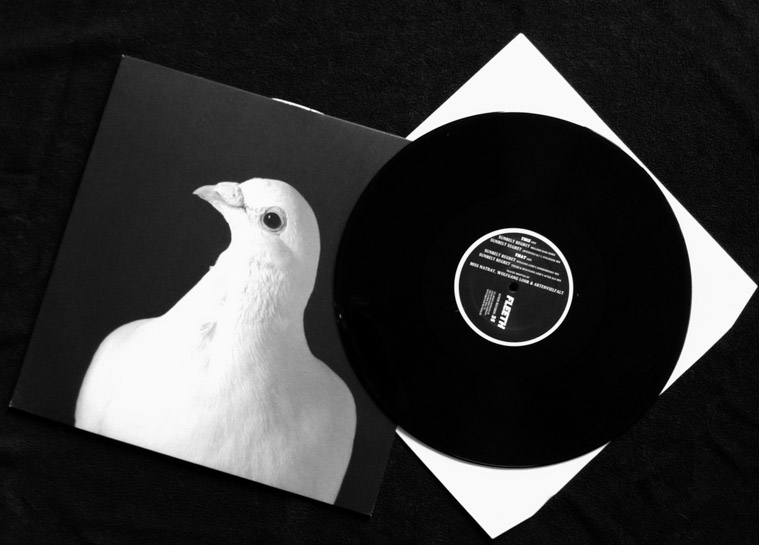
We cared for and loved little Clive — a lost and unwanted racing pigeon. Clive was in a local animal shelter with a flesh injury when we first met him. His cage label said “Snowflake” and his cage card detailed his his wound treatment and his meds.
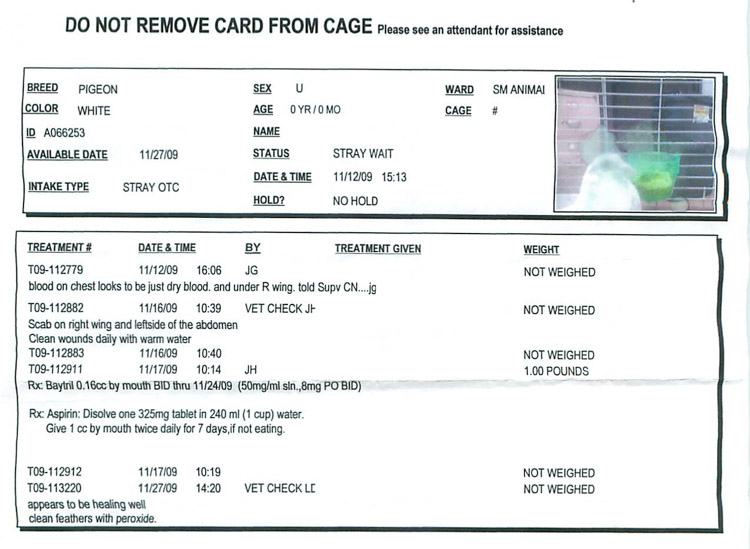
The shelter had contacted our friend at MickaCoo Pigeon and Dove Rescue in San Francisco, looking for possible rescue or placement. We picked up “Snowflake” from the shelter with the expectation that his owner wouldn’t want “damaged” and injured “goods” returned. That’s often the case in a sport where a hard, utilitarian ethic still persists. And here was Snowflake, who not only didn’t place in a race, he didn’t even make it home. He was a hawk-strike victim and a potential veterinary and financial liability.
When I tracked down the club through Snowflake’s band number and told the owner where the pigeon could be retrieved, the man told me, “no, it would cost me more to pick up that pigeon than he’s worth.” Had I offered to return the pigeon myself to a man who professed this lack of regard for the bird, Snowflake’s future would most likely have been sealed in a quick kill or cull. So, we took him into our humble, urban digs. (I later found a Craig’s List ad by this same owner, selling similar white racing pigeons for ten dollars.)
We hoped that Snowflake would befriend a 10-year-old racer we’d rescued a few months prior — Chauncey, so named after Chauncey Gardiner, our cinematic allusion to displacement. It took just a day for us to realize that Snowflake wasn’t a snowflake at all in temperament — he was robust and assertive, and we thought he’d be better suited to a manly designation. We started with Clyde for its rhythm (“Chauncey and Clyde”), but Clyde soon morphed into Clive. It also didn’t take long for Chauncey to reveal that “he” was a “she” — when she hooked up with this stunning white racer who was nine years her junior.
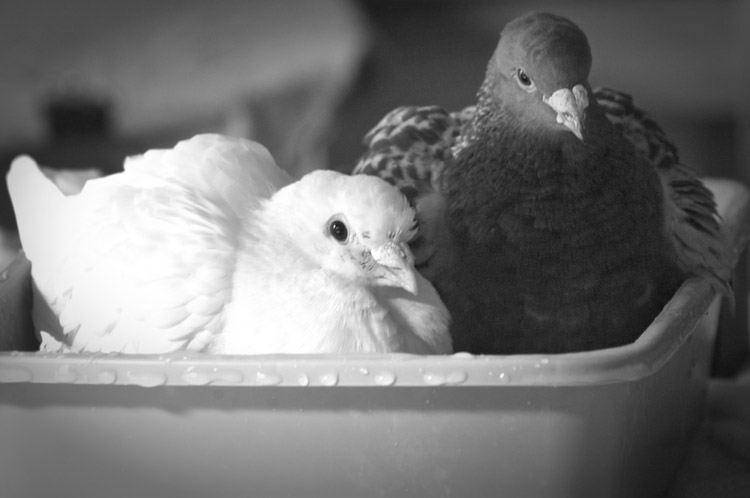
After some weeks, Clive’s hawk injury healed to perfection, with no visible disability or flight impairment. In fact, when we’d take Chauncey and Clive to the vet, the doctor always remarked on how beautiful and muscular both birds were. They were built to fly — fast and far. Young Clive had the energy of a thoroughbred. We had their racing bands removed and I swear, from all of the preening and leg lifting they did, it must have felt like the weight of a lifetime disappeared from their ankles.
Clive never left Chauncey’s side except to retrieve sticks for his nest building, an activity he undertook with fervor. These two birds remained bonded until Chauncey died from cancer earlier this year.
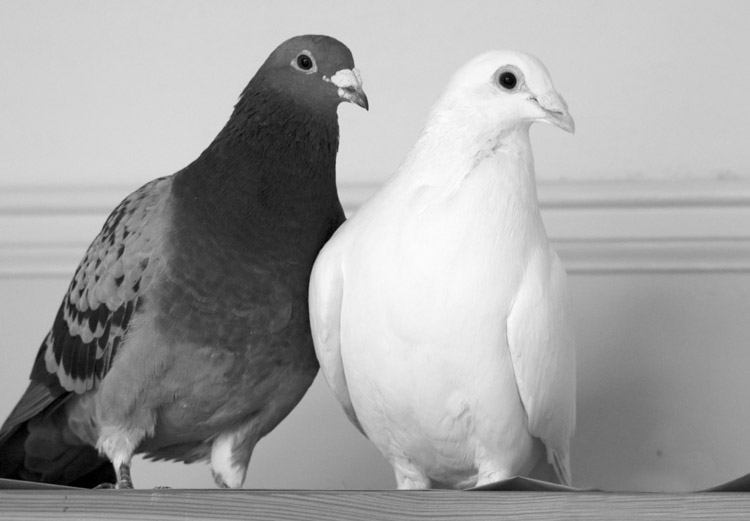
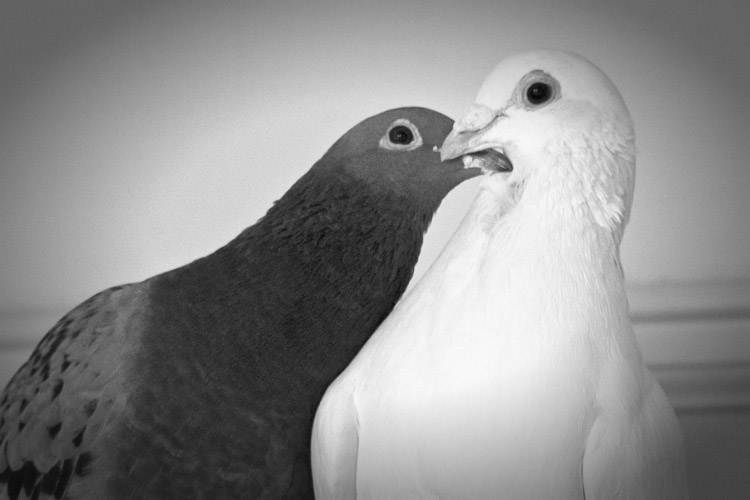
Someday, I will write the story of how profoundly altered I was by this association … how my life intertwined with theirs in such a way that I became a different human being — from my cells into my outward consciousness. And, then, how I dripped tears into my tea for weeks and months after we retired them to a gorgeous new home. It was a significant upgrade from their indoor life in our place, in a huge aviary that more resembled a magical forest than it did any enclosure.
My heart still aches a bit every time I look at photos of Chauncey and Clive, even though it seems like a long time ago now that I draped a black cloth behind Clive’s perch and photographed that catch light in his eye. I still miss them, even a few years later. I’d forgotten that Acker Records requested usage of this image for a music project. So, when I cut open this brown cardboard envelope, I had no idea what I would find inside. I was — honestly — overcome. I told Hugh this is probably the most interesting outcome of any photo I’ve sold or licensed. Each album in this series of dance/electronica music features black-and-white animal photos. And, Clive now graces the cover of the EP “Fleeth” with tracks by Miss Natnat, Wolfgang Lohr and Artenvielfalt … in pose and picture that made me think of old Blue Note Records covers. It made me glad we decided to name him Clive. “Snowflake” just wouldn’t be the same.
—————–
I cannot adequately express how lovely these birds are — domestic pigeons of all types. If you have the space and ever have the inclination to give a few rescued birds an aviary home, they will endear you with their gentleness, their intelligence and their beauty. MickaCoo Pigeon and Dove Rescue, a dedicated organization that literally saved us from desperation when we didn’t know how to care for these birds, always has pigeons and doves available for adoption. They always need foster homes and other assistance. In the interest of full disclosure … I’m now a member and supporter of MickaCoo, and we plan to someday permanently adopt more birds in need. But, my organizational affiliation has no bearing on my personal feelings about pigeons. That all comes from life with Chauncey and Clive, two of our Zen teachers.

Congrats on the album cover, and the choice of B&W for the images couldn’t have been better. I also had recent encounters with Zenaida and White Winged-doves, and I understand and feel for their gentle and gregarious nature. We share our building here with Zenaidas, Rock Pigeons, White-winged doves, and the Common-ground little doves. I am also glad they’re in an aviary, well protected.
It’s a fun usage of the photo … and yes, the gentleness strikes me every time I interact with these birds. I wasn’t 100 percent sure on Zenaidas, so I had to look them up. You’ve got a wild aviary in your building!
The “Zenaida Dove” I was talking about retained the name of its genus “Zenaida”, and it’s exclusive to the Caribbean and Yucatan Peninsula. It is smaller than the “Mourning Dove” and its call is very similar. For some reason, Puerto Rico is full of them now, and the “Mourning Dove”, even though it lives here, is more rare. In the U.S. the Zenaida was only sighted at the very southern tip of Florida, but the Mourning Dove is virtually everywhere.
We live in a condo in front of the ocean, but it’s very urban because an extensive sector of San Juan has residential condos in front of the ocean. I get to see very little wildlife here but the doves I mentioned. I also see Brown Pelicans and some terns, but the truth is that San Juan has virtually destroyed part of its coastline, where sea turtles, American Oystercatchers, and sanderlings could come to visit, but don’t because its dense human population and beach-front condos have invaded their shoreline.
I have read some of your posts about Rock Pigeons, and empathise with your compassion towards them (specifically the post where you untangled one with your husband). We share our building with them. They nest in every crevice, ledge, and under the air conditioning units of these condos. They don’t nest here now because they recently painted, but soon a nesting pair will appear somewhere.
Thank you for sharing this Ingrid, it touched me. It is amazing how animals can touch and change us.
Mia, I’m often in discussion with people who have diverse ideas about what our relationship to animals should be. Selfishly speaking, I simply cannot imagine a life without them, or without interaction of some significant kind … even if it’s through the distance of a lens. I don’t think I’m being hyperbolic to say that my life would lose much value if nonhuman animals didn’t share our space.
I fully understand your fondness for pigeons, Ingrid. I raised them in my early teens in California (had to give them up when we moved back to frigid northern Montana) and I was absolutely devoted to them. They were gentle and had personalities of their own. I spent every spare minute I had in the pigeon coop with my birds (homers, jacobins, fantails, tipplers, tumblers, rollers etc). My mother encouraged my interest and later told me that the pigeons had “kept me out of trouble”. She was probably right.
Ron, you know so much more about pigeons than I do, especially in terms of identifying them. I’ve been putting together a photo gallery of pigeon types for a volunteer project, and can’t believe the diversity of domestic breeds. Do you have a favorite? You’ve probably heard some of the comments Mike Tyson’s made about pigeons and how they anchored and formed his youth as well.
Your photos are wonderful…I’ve just found your site and have looked through some of your work. I especially like the Humble Places series, and really appreciate your wildlife ethics page. I am often concerned by the photos and video featuring animals these days…so many of them seem questionable at best…especially the “cute” animals. Glad to see you are protecting the wild creatures you photograph! Thanks for sharing your wonderful art!
Denise, thanks very much for stopping by and commenting. What interesting and lovely work you do! My husband and I are enamored with interpretive signs. If I don’t have time to read them, I’ll photograph them so I can catch up on the information later. I’ll look for the ones in your portfolio when I have the chance to visit those spots.
As far as ethics, I recognize that it’s impossible to be perfect in this regard … and I have to curb my enthusiasm, as it were, if I feel too much excitement for a photograph. I agree with you completely about the suspect methodology involved in some images and videos. I got into it a bit last year with some photogs in the field. If you link out to the amazing photographers who commented here in this thread, they are even more diligent than I am in terms of their craft and ethics. I feel fortunate to have met people who share my views on this and who produce stunning work without those ethical breaches.
I might have missed it but is Clive still alive?
Hi, Mike … yes, Clive is still alive, living in a beautiful aviary in Northern California, thanks to a generous bird rescuer. To date, he does not have a new mate although I’d like to see that happen for him. He was a year old when he paired with 10-year-old Chauncey.